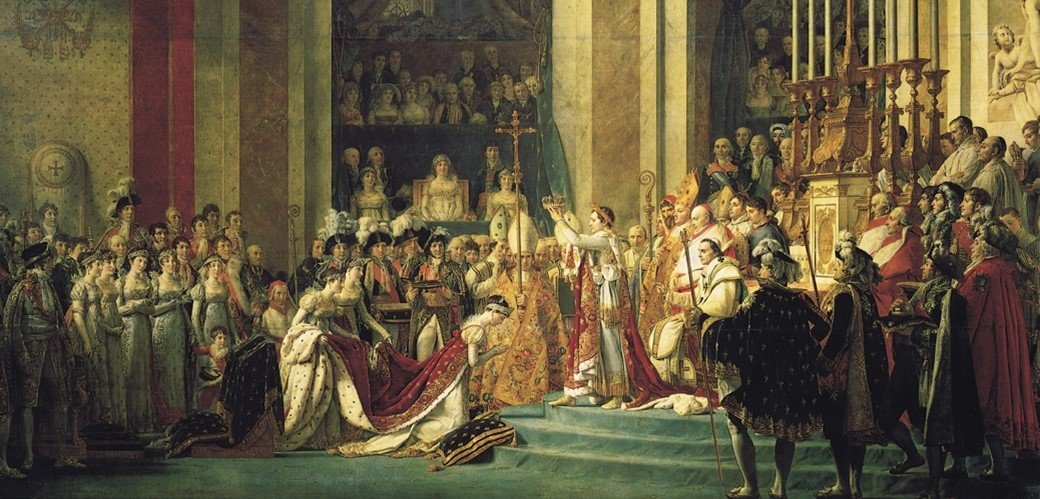The Battle of Austerlitz, 1805
(Rapp Presenting Prince Repnin-Volkonsky, François Gérard)
By Natty Croucher, Third-Year History
“It will be enough for one of you to say, 'I was at the battle of Austerlitz;' for all your fellow citizens to exclaim, 'There is a brave man.'"
These were the final words of Napoleon to his Grand Armée after their decisive victory against the Austro-Russian forces of the Third Coalition at Austerlitz on December 2nd, 1805. Allied casualties, killed and wounded, totalled around 16,000 from an estimated force of 85,000; their forces either "cut to pieces or dispersed". The Peace of Pressburg that followed effectively marked the end of the War of the Third Coalition (that had begun in April 1805) and led to the dissolution of the infamous Holy Roman Empire, which had existed for almost a millennium.
By the time the Battle of Austerlitz had begun, it had been six years since Napoleon's seizure of overarching power in France in the Coup of 18 Brumaire (or November 9th 1799), installing himself as First Consul. He had, by 1802, already fended off the Second Coalition of European and Ottoman forces in a cross-continental theatre of war, ensuring the survival of the French Republic and their previous annexations in Europe. On December 2nd 1804, exactly a year before the Battle of Austerlitz, Napoleon was crowned Emperor of the First French Empire.
(The Coronation of Napoleon, Jacques-Louis David, 1807)
By April 1805, however, war had once again broken out on the continent.
The Grand Armée held much momentum in the latter months of 1805, having decisively defeated a large Austrian force during the Ulm Campaign of September and October of the same year. By its end, the French had captured 60,000 Austrian soldiers, who, under General Mack, had surrendered in the face of encirclement by Napoleon's army, in moves that exemplified the Emperor's strategic prowess. The celebrations of the French chain of command, however, were almost certainly dampened by news of Admiral Nelson's crushing victory against the Franco-Spanish fleet at the legendary battle of Trafalgar, which was occurring just as the Austrians were laying down their arms on the land of central Europe.
(Ulm Capitulation, René Théodore Berthon)
It was in the backdrop of British Naval supremacy and French land superiority that the battle of Austerlitz lay, on the landscape of the Pratzen Heights in modern-day Czechia. This gently sloping hill provided the ground upon which an Austro-Russian force numbering approximately 85,000 - largely consisting of Russian soldiers - was formed, along with over 300 artillery pieces. Certainly a daunting sight for Napoleon's army of 72,000 and considerably fewer guns.
But the Emperor had a plan.
Napoleon had previously evacuated a position on the Pratzen Heights as a means by which to draw the Allied army into battle, offering them an advantageous position for confrontation. Once they had taken it up, he intended to split the large force of his enemy by feigning weakness on his right flank, believing that this would tempt much of the Austro-Russian force away from its main body in anticipation of a significant early victory - and indeed one which would also reopen the route to Vienna, the de-facto capital of the Holy Roman Empire.
Once this had occurred, he theorised that the main force of the Grand Armée, hidden prior by a combination of morning mist and the nature of the landscape, could then surge up the Pratzen heights and inflict a swift and decisive defeat on the Allied forces that remained on the hill, then turning attention to its isolated left and right flanks.
In order to guarantee that the "weakened" French right flank could keep Austro-Russian forces occupied whilst the majority of his army engaged the Allied centre and right, Napoleon ordered Marshal Louis-Nicolas Davout to march from Vienna to provide cover for the small number of regiments that remained. In the end, Davout and his Third Corps marched almost 70 miles in 48 hours, arriving just in time to keep the battle on the right flank in contention.
By 9 am on December 2nd, an hour since the Allied forces had fallen for Napoleon's trickery and shifted a large number of troops towards the French right, the Emperor finally ordered an assault on the remaining forces on Pratzen heights, spearheaded by General St. Hilaire, who led a division of Marshal Soult's IV Corps that numbered 16,000.
A bloody battle ensued, combining musket fire, bayonet charge and mounted combat. Through a combination of surprise, bravery and ruthlessness, the French were able to occupy the heights. Having taken control of the centre enabled French forces to swing around into the Austro-Russian right flank, which by that point was still witnessing bitter fighting and an Allied numerical advantage. However, by the early afternoon, Austro-Russian forces had sounded the retreat, taking a number of casualties as the withdrawing troops were cut down by an onslaught of French cavalry.
The final action of Napoleon's army was to relieve their right flank, where Davout's corps was still engaging a significant number of Allied forces in and around the village of Telnitz. At the sight of the Grand Armée approaching from a number of angles, the remaining Allied forces fled in a disorderly manner in all possible directions, suffering both artillery fire and the harrying of cavalry as they did so.
By the end, estimates on Austro-Russian casualties (including wounded and captured) stand at around 36,000, or 42% of their 85,000-strong fighting force (though estimates on their total number vary). Conversely, recorded casualties of the Grand Armée linger at around 8,500 of a force of 72,000. Napoleon had, through strategic savvy and effective organisation, delivered a decisive and fatal blow to Allied hopes of victory once again, reshaping the European landscape of power in doing so.
William Pitt the Elder, the Prime minister of Britain, expressed shortly after receiving news of the defeat: "roll up that map (of Europe), it will not be needed these ten years".




